Avaya 1408, 1416, 1608, 1616 User Guide

IP Office Release 6.0
1408, 1416, 1608 and 1616 Phone
Guide
15-601040 Issue 03g - (19 November 2010)

© 2010 AVAYA All Rights Reserved.
Notices
While reasonable efforts have been made to ensure that the information in this document is complete and accurate at the time of printing, Avaya assumes no liability for any errors. Avaya reserves the right to make changes and corrections to the information in this document without the obligation to notify any person or organization of such changes.
Documentation disclaimer
Avaya shall not be responsible for any modifications, additions, or deletions to the original published version of this documentation unless such modifications, additions, or deletions were performed by Avaya.
End User agree to indemnify and hold harmless Avaya, Avaya's agents, servants and employees against all claims, lawsuits, demands and judgments arising out of, or in connection with, subsequent modifications, additions or deletions to this documentation, to the extent made by End User.
Link disclaimer
Avaya is not responsible for the contents or reliability of any linked Web sites referenced within this site or documentation(s) provided by Avaya. Avaya is not responsible for the accuracy of any information, statement or content provided on these sites and does not necessarily endorse the products, services, or information described or offered within them. Avaya does not guarantee that these links will work all the time and has no control over the availability of the linked pages.
Warranty
Avaya provides a limited warranty on this product. Refer to your sales agreement to establish the terms of the limited warranty. In addition, Avaya’s standard warranty language, as well as information regarding support for this product, while under warranty, is available to Avaya customers and other parties through the Avaya Support Web site: http://www.avaya.com/support. Please note that if you acquired the product from an authorized Avaya reseller outside of the United States and Canada, the warranty is provided to you by said Avaya reseller and not by Avaya.
Licenses
THE SOFTWARE LICENSE TERMS AVAILABLE ON THE AVAYA WEBSITE, HTTP://SUPPORT.AVAYA.COM/LICENSEINFO/ ARE APPLICABLE TO ANYONE WHO DOWNLOADS, USES AND/OR INSTALLS AVAYA SOFTWARE, PURCHASED FROM AVAYA INC., ANY AVAYA AFFILIATE, OR AN AUTHORIZED AVAYA RESELLER (AS APPLICABLE) UNDER A COMMERCIAL AGREEMENT WITH AVAYA OR AN AUTHORIZED AVAYA RESELLER. UNLESS OTHERWISE AGREED TO BY AVAYA IN WRITING, AVAYA DOES NOT EXTEND THIS LICENSE IF THE SOFTWARE WAS OBTAINED FROM ANYONE OTHER THAN AVAYA, AN AVAYA AFFILIATE OR AN AVAYA AUTHORIZED RESELLER, AND AVAYA RESERVES THE RIGHT TO TAKE LEGAL ACTION AGAINST YOU AND ANYONE ELSE USING OR SELLING THE SOFTWARE WITHOUT A LICENSE. BY INSTALLING, DOWNLOADING OR USING THE SOFTWARE, OR AUTHORIZING OTHERS TO DO SO, YOU, ON BEHALF OF YOURSELF AND THE ENTITY FOR WHOM YOU ARE INSTALLING, DOWNLOADING OR USING THE SOFTWARE (HEREINAFTER REFERRED TO INTERCHANGEABLY AS “YOU” AND “END USER”), AGREE TO THESE TERMS AND CONDITIONS AND CREATE A BINDING CONTRACT BETWEEN YOU AND AVAYA INC. OR THE APPLICABLE AVAYA AFFILIATE (“AVAYA”).
Avaya grants End User a license within the scope of the license types described below. The applicable number of licenses and units of capacity for which the license is granted will be one (1), unless a different number of licenses or units of capacity is specified in the Documentation or other materials available to End User. "Designated Processor" means a single stand-alone computing device. "Server" means a Designated Processor that hosts a software application to be accessed by multiple users. "Software" means the computer programs in object code, originally licensed by Avaya and ultimately utilized by End User, whether as stand-alone products or pre-installed on Hardware. "Hardware" means the standard hardware originally sold by Avaya and ultimately utilized by End User.
License types
Designated System(s) License (DS). End User may install and use each copy of the Software on only one Designated Processor, unless a different number of Designated Processors is indicated in the Documentation or other materials available to End User. Avaya may require the Designated Processor(s) to be identified by type, serial number, feature key, location or other specific designation, or to be provided by End User to Avaya through electronic means established by Avaya specifically for this purpose.
Copyright
Except where expressly stated otherwise, no use should be made of materials on this site, the Documentation(s) and Product(s) provided by Avaya. All content on this site, the documentation(s) and the product(s) provided by Avaya including the selection, arrangement and design of the content is owned either by Avaya or its licensors and is protected by copyright and other intellectual property laws including the sui generis rights relating to the protection of databases. You may not modify, copy, reproduce, republish, upload, post, transmit or distribute in any way any content, in whole or in part, including any code and software. Unauthorized reproduction, transmission, dissemination, storage, and or use without the express written consent of Avaya can be a criminal, as well as a civil, offense under the applicable law.
Third Party Components
Certain software programs or portions thereof included in the Product may contain software distributed under third party agreements ("Third Party Components"), which may contain terms that expand or limit rights to use certain portions of the Product ("Third Party Terms"). Information regarding distributed Linux OS source code (for those Products that have distributed the Linux OS source code), and identifying the copyright holders of the Third Party Components and the Third Party Terms that apply to them is available on the Avaya Support Web site: http://support.avaya.com/Copyright.
Preventing toll fraud
"Toll fraud" is the unauthorized use of your telecommunications system by an unauthorized party (for example, a person who is not a corporate employee, agent, subcontractor, or is not working on your company's behalf). Be aware that there can be a risk of toll fraud associated with your system and that, if toll fraud occurs, it can result in substantial additional charges for your telecommunications services.
Avaya fraud intervention
If you suspect that you are being victimized by toll fraud and you need technical assistance or support, call Technical Service Center Toll Fraud Intervention Hotline at +1-800-643-2353 for the United States and Canada. For additional support telephone numbers, see the Avaya Support Web site: http://support.avaya.com
Suspected security vulnerabilities with Avaya products should be reported to Avaya by sending mail to: securityalerts@avaya.com.
Trademarks
Avaya and Aura are trademarks of Avaya, Inc.
The trademarks, logos and service marks (“Marks”) displayed in this site, the documentation(s) and product(s) provided by Avaya are the registered or unregistered Marks of Avaya, its affiliates, or other third parties. Users are not permitted to use such Marks without prior written consent from Avaya or such third party which may own the Mark. Nothing contained in this site, the documentation(s) and product(s) should be construed as granting, by implication, estoppel, or otherwise, any license or right in and to the Marks without the express written permission of Avaya or the applicable third party. Avaya is a registered trademark of Avaya Inc. All non-Avaya trademarks are the property of their respective owners.
Downloading documents
For the most current versions of documentation, see the Avaya Support Web site: http://www.avaya.com/support
Contact Avaya Support
Avaya provides a telephone number for you to use to report problems or to ask questions about your product. The support telephone number is 1-800-242-2121 in the United States. For additional support telephone numbers, see the Avaya Web site: http://www.avaya.com/support
1408, 1416, 1608 and 1616 Phone Guide |
Page 2 |
IP Office Release 6.0 |
15-601040 Issue 03g (19 November 2010) |

Contents
Contents |
|
|
1. |
Introduction |
|
1.1 |
Important Safety.....................................................................Information |
9 |
1.2 |
1408 and 1608.....................................................................Phones |
10 |
1.3 |
1416 and 1616.....................................................................Phones |
11 |
1.4 |
Button Modules..................................................................... |
12 |
1.5 Phone Keys..................................................................... |
13 |
|
1.6 |
The Phone.....................................................................Stand |
14 |
1.7 |
Labels ..................................................................... |
15 |
1.8 |
IP Phone Features.....................................................................(1608 and 1616) |
15 |
1.9 The Main Phone.....................................................................Menus |
16 |
|
1.10 Other Menus..................................................................... |
18 |
|
1.11 Appearance.....................................................................Buttons/Menu |
19 |
|
|
1.11.1............................................................................Using the Appearance Menu |
20 |
|
1.11.2............................................................................Phone Status Letters |
20 |
|
1.11.3............................................................................Call Apperance Buttons |
21 |
|
1.11.4............................................................................Bridged Appearance Buttons |
23 |
|
1.11.5............................................................................Call Coverage Buttons |
25 |
|
1.11.6............................................................................Line Appearance Buttons |
27 |
2. |
Making Calls |
|
2.1 |
En-Bloc Dialing..................................................................... |
31 |
2.2 |
Call Soft Key.....................................................................Options |
32 |
2.3 |
Calling a Person.....................................................................from the Contacts List |
33 |
2.4 |
Calling a Person.....................................................................from the Call Log |
34 |
2.5 |
Redialling a.....................................................................Previous Number |
35 |
2.6 |
Making a Page.....................................................................Call |
36 |
2.7 |
Withholding.....................................................................Your Number |
37 |
2.8 |
Adjust the Call.....................................................................Volume |
38 |
2.9 |
Muting a Call..................................................................... |
38 |
2.10 Ending Calls..................................................................... |
38 |
|
6. |
Transferring Calls |
|
6.1 |
Transfer to.....................................................................Voicemail |
61 |
6.2 |
Transferring.....................................................................a Held Call |
61 |
7. Account Codes |
|
|
7.1 |
Forced Account.....................................................................Code Entry |
64 |
7.2 |
Manual Account.....................................................................Code Entry |
65 |
8. |
Conference Calls |
|
8.1 |
Starting a Conference..................................................................... |
68 |
8.2 |
Adding a Call.....................................................................to a Conference |
68 |
8.3 Viewing Conference.....................................................................Details |
69 |
|
8.4 |
Dropping Parties.....................................................................from a Conference |
69 |
8.5 |
Holding a Conference.....................................................................Call |
70 |
8.6 |
Transferring.....................................................................Calls Using Conference |
70 |
9. |
Headset Operation |
|
9.1 |
Headset Volume..................................................................... |
72 |
9.2 |
Default Handsfree.....................................................................Audio Path |
73 |
10.Handsfree Speaker Operation
10.1 |
Speaker Volume..................................................................... |
76 |
10.2 |
Default Handsfree.....................................................................Audio Path |
77 |
11.Contacts/Directory
11.1 |
Viewing Contacts.....................................................................Details |
81 |
11.2 |
Make a Call.....................................................................from the Directory |
82 |
11.3 |
Using the.....................................................................Directory for Other Functions |
83 |
11.4 |
Adding a New.....................................................................Contact |
84 |
11.4.1............................................................................Add a Contact from the Call Log |
85 |
|
11.4.2............................................................................Add a Contact from the Redial List |
86 |
|
11.5 |
Editing a Contact..................................................................... |
87 |
11.6 |
Deleting a.....................................................................Contact |
88 |
3. |
Answering Calls |
|
3.1 |
Divert a Call.....................................................................to Voicemail |
41 |
3.2 |
Ignore an Incoming.....................................................................Call |
41 |
3.3 |
Answering .....................................................................a Page Call |
42 |
3.4 Auto Answer..................................................................... |
43 |
|
3.5 |
Call Pickup..................................................................... |
44 |
4. |
Redialling |
|
4.1 |
Redial a Call.....................................................................(One Mode) |
46 |
4.2 |
Redial a Call.....................................................................(List Mode) |
46 |
4.3 |
Selecting Your.....................................................................Redial Mode |
47 |
4.4 |
View Call Details..................................................................... |
48 |
4.5 |
Add a Call .....................................................................to Your Contacts |
49 |
5. Holding and Parking Calls |
|
|
5.1 |
Holding Calls..................................................................... |
53 |
|
5.1.1 Holding............................................................................a Call |
53 |
|
5.1.2 Taking............................................................................a Call Off Hold |
53 |
|
5.1.3 Switching............................................................................Between Calls |
54 |
|
5.1.4 Transfer............................................................................a Held Call |
54 |
5.2 |
Parking Calls..................................................................... |
55 |
|
5.2.1 Park............................................................................Using the Menu |
56 |
|
5.2.2 Unpark............................................................................(Features Menu) |
57 |
|
5.2.3 Unpark............................................................................(Status Menu) |
57 |
12.Call Log |
|
|
12.1 |
Using the.....................................................................Call Log |
91 |
12.2 |
Making a .....................................................................Call from the Call Log |
91 |
12.3 |
Viewing Call.....................................................................Details |
92 |
12.4 |
Deleting a.....................................................................Record |
93 |
12.5 |
Deleting All.....................................................................Records |
93 |
12.6 |
Adding a Record.....................................................................to Your Contacts |
94 |
13.Voicemail |
|
|
13.1 |
Message .....................................................................Waiting Indication |
96 |
13.2 Checking .....................................................................Messages |
97 |
|
13.3 |
Sending a.....................................................................Message |
98 |
13.4 |
Mailbox Greeting..................................................................... |
99 |
13.5 |
Email Mode..................................................................... |
100 |
13.6 |
Changing.....................................................................Your Voicemail Code |
101 |
13.7 |
Voicemail.....................................................................On/Off |
102 |
13.8 |
Transfer.....................................................................to Voicemail |
103 |
13.9 |
Send a Call.....................................................................to Voicemail |
103 |
13.10 Visual Voice..................................................................... |
104 |
|
14.Logging In/Out |
|
|
14.1 |
Logging .....................................................................In |
107 |
14.1.............................................................................1 Logging In on a Phone Already in Use |
108 |
|
14.1.............................................................................2 Logging In on a Not Logged In Phone |
109 |
|
14.1.............................................................................3 Logging In on an Unregistered Phone |
110 |
|
1408, 1416, 1608 and 1616 Phone Guide |
Page 3 |
IP Office Release 6.0 |
15-601040 Issue 03g (19 November 2010) |

14.2 |
Logout ..................................................................... |
111 |
17.2............................................................................. |
20 Self-Administer |
153 |
|
14.3 |
Lock ..................................................................... |
112 |
17.2............................................................................. |
21 |
Send All Calls |
153 |
14.4 |
Auto Lock..................................................................... |
113 |
17.2............................................................................. |
22 |
Set Hunt Group Night Service |
154 |
14.5 |
Unlock ..................................................................... |
114 |
17.2............................................................................. |
23 |
Time of Day |
154 |
14.6 |
Changing.....................................................................Your Login Code |
115 |
17.2............................................................................. |
24 |
Timer |
154 |
14.7 Unregistering..................................................................... |
116 |
17.2............................................................................. |
25 |
User |
155 |
|
15.Redirecting Calls |
|
18.Phone Settings |
|
|
||||||
15.1 Follow Me..................................................................... |
119 |
18.1 |
Mobile Twinning..................................................................... |
159 |
|
|||||
15.1............................................................................. |
1 |
Follow Me To (Features Menu) |
120 |
18.2 |
Withhold.....................................................................Number |
160 |
|
|||
15.1............................................................................. |
2 |
Follow Me (Status Menu) |
121 |
18.3 |
Redial Mode..................................................................... |
161 |
|
|||
15.1............................................................................. |
3 |
Follow Me Here (Features Menu) |
122 |
18.4 |
En-Bloc .....................................................................Dialing |
162 |
|
|||
15.2 Forwarding.....................................................................Calls |
123 |
18.5 |
Erase Options..................................................................... |
163 |
|
|||||
15.2............................................................................. |
1 |
Forward Unconditional (Status Menu) |
125 |
18.6 |
Auto Lock..................................................................... |
164 |
|
|||
15.2............................................................................. |
2 |
Forward Unconditional (Features Menu) |
126 |
18.7 |
Ringer Controls..................................................................... |
165 |
|
|||
15.2............................................................................. |
3 |
Forward On No Answer (Status Menu) |
128 |
18.7............................................................................. |
1 |
Disabling the Ringer |
166 |
|
||
15.2............................................................................. |
4 |
Forward On Busy (Status Menu) |
129 |
18.7............................................................................. |
2 |
Visual Alerting |
167 |
|
||
|
15.2.5 Forward On Busy/No Answer (Features |
|
18.7............................................................................. |
3 |
Audible Alerting |
168 |
|
|||
|
Menu)............................................................................ |
|
130 |
18.7............................................................................. |
4 Coverage Ring |
169 |
|
|||
15.3 Do Not Disturb..................................................................... |
132 |
18.7............................................................................. |
5 |
Ring Sound |
170 |
|
||||
15.3............................................................................. |
1 |
DND On/Off (Features Menu) |
133 |
18.7............................................................................. |
6 |
Ringer Volume |
171 |
|
||
15.3............................................................................. |
2 |
DND Off (Status Menu) |
133 |
18.7............................................................................. |
7 |
Internal Auto Answer |
171 |
|
||
15.3............................................................................. |
3 |
Do Not Disturb Exceptions |
134 |
18.8 |
Display Controls..................................................................... |
172 |
|
|||
15.4 Twinning..................................................................... |
135 |
18.8............................................................................. |
1 |
Display Brightness |
172 |
|
||||
15.4............................................................................. |
1 |
Mobile Twinning Control |
136 |
18.8............................................................................. |
2 |
Display Contrast |
173 |
|
||
16.Groups |
|
18.8............................................................................. |
3 |
Call Timer Display |
174 |
|
||||
|
18.8 |
4 Display Language |
176 |
|
||||||
16.1 Group Membership |
139 |
|
||||||||
18.8 |
5 Display Name |
177 |
|
|||||||
16.1 |
1 |
Group Membership On/Off (Status Menu) |
139 |
|
||||||
18.8 |
6 |
A-Menu Auto Exit |
178 |
|
||||||
16.1 |
2 |
Group Membership On/Off (Features Menu) |
140 |
|
||||||
18.8 |
7 |
Show Call Waiting |
179 |
|
||||||
16.2 Group Service Status and Fallback |
141 |
|
||||||||
18.8 |
8 |
Inactivity Timer (Auto Return) |
180 |
|
||||||
|
16.2.1 Changing the Group Service Status |
|
|
|||||||
|
|
18.9 Volume and Sound |
181 |
|
||||||
|
(Features Menu) |
142 |
|
|||||||
|
18.9 |
1 |
Button Clicks |
182 |
|
|||||
|
16.2.2 Changing the Group Service Status (Status |
|
|
|||||||
|
|
18.9 |
2 |
Error Tones |
182 |
|
||||
|
Menu)............................................................................ |
|
144 |
|
||||||
16.2............................................................................. |
3 |
Changing the Group Fallback |
145 |
18.9............................................................................. |
3 |
Ringer Volume |
183 |
|
||
17.Button Features |
|
18.9............................................................................. |
4 Handset Volume |
183 |
|
|||||
|
18.9............................................................................. |
5 Headset Volume |
183 |
|
||||||
17.1 Programming.....................................................................a Button |
148 |
18.9............................................................................. |
6 Speaker Volume |
183 |
|
|||||
17.2 Features..................................................................... |
150 |
18.9............................................................................. |
7 |
Automatic Gain Control |
184 |
|
||||
17.2............................................................................. |
1 |
Abbreviated Dial |
151 |
18.9............................................................................. |
8 |
Default Handsfree Audio Path |
185 |
|
||
17.2............................................................................. |
2 |
Abbreviated Dial Program |
151 |
18.10 Backup/Restore..................................................................... |
186 |
|
||||
17.2............................................................................. |
3 |
Account Code Entry |
151 |
18.10............................................................................1 Backup |
186 |
|
||||
17.2............................................................................. |
4 |
AD Suppress |
151 |
18.10............................................................................2 Restore |
187 |
|
||||
17.2............................................................................. |
5 |
Automatic Callback |
151 |
18.11 Viewing.....................................................................Information |
188 |
|
||||
17.2............................................................................. |
6 |
Breakout |
151 |
19.Status Menu |
|
|
||||
17.2............................................................................. |
7 |
Call Forwarding All |
151 |
|
|
|||||
17.2............................................................................. |
8 |
Call Park |
152 |
19.1 |
Do Not Disturb..................................................................... |
193 |
|
|||
17.2............................................................................. |
9 |
Call Park to Other Ext |
152 |
19.2 |
Follow Me.....................................................................To |
193 |
|
|||
17.2............................................................................. |
10 Call Pickup |
152 |
19.3 |
Follow Me.....................................................................Here |
194 |
|
||||
17.2............................................................................. |
11 Directed Call Pickup |
152 |
19.4 |
Forward.....................................................................On Busy |
195 |
|
||||
17.2............................................................................. |
12 Directory |
152 |
19.5 |
Forward.....................................................................On No Answer |
196 |
|
||||
17.2............................................................................. |
13 Drop |
152 |
19.6 Forward.....................................................................Unconditional |
197 |
|
|||||
17.2............................................................................. |
14 Flash Hook |
152 |
19.7 Forwarded.....................................................................Here |
198 |
|
|||||
17.2............................................................................. |
15 Group |
153 |
19.8 Group Membership..................................................................... |
199 |
|
|||||
17.2............................................................................. |
16 Group Paging |
153 |
19.9 |
Group Service.....................................................................Status |
199 |
|
||||
17.2............................................................................. |
17 Headset Toggle |
153 |
19.10 Mobile .....................................................................Twinning |
200 |
|
|||||
17.2............................................................................. |
18 Internal Auto Answer |
153 |
19.11 Parked.....................................................................Calls |
200 |
|
|||||
17.2............................................................................. |
19 Ringer Off |
153 |
19.12 System.....................................................................Alarms |
201 |
|
|||||
|
|
|
|
|
|
|
||||
|
1408, 1416, 1608 and 1616 Phone Guide |
|
|
|
|
|
Page 4 |
|
||
IP Office Release 6.0 |
|
|
|
|
15-601040 Issue 03g (19 November 2010) |
|||||

Contents
23.33 Twinning..................................................................... |
243 |
20.Short Codes
21.System Administration
Index ............................................................................... |
245 |
21.1 |
Checking.....................................................................the System and Software Version |
209 |
21.2 |
Setting the.....................................................................Date |
210 |
21.3 |
Setting the.....................................................................Time |
212 |
21.4 |
Setting the.....................................................................Time Offset |
214 |
21.5 |
Checking.....................................................................the Time Server Status |
216 |
21.6 System Shutdown..................................................................... |
217 |
|
21.7 Memory .....................................................................Card Management |
219 |
|
21.8 |
System Alarms..................................................................... |
221 |
22.The Phone Menus
22.1 |
Features.....................................................................Menu |
225 |
22.2 |
Self-Administer.....................................................................Menu |
227 |
22.3 |
Visual Voice.....................................................................Menu |
228 |
22.4 |
Status Menu..................................................................... |
229 |
22.5 Phone A.....................................................................-Menu |
230 |
|
22.6 |
Call Log.....................................................................Menu |
232 |
22.7 |
Contacts.....................................................................Menu |
233 |
22.8 |
Redial Menu..................................................................... |
234 |
22.9 Phone Locked.....................................................................Menu |
235 |
|
22.10 System.....................................................................Admin Menu |
236 |
|
22.11 Error Screens..................................................................... |
237 |
|
23.Glossary
23.1 |
Abbreviated.....................................................................Ring |
240 |
|
||
23.2 |
Appearance.....................................................................Button |
240 |
|
||
23.3 |
Attention.....................................................................Ring |
240 |
|
||
23.4 |
Auto Hold..................................................................... |
240 |
|
||
23.5 |
Bridged Appearance.....................................................................Button |
240 |
|
||
23.6 |
Call Appearance.....................................................................Button |
240 |
|
||
23.7 |
Call Coverage.....................................................................Button |
240 |
|
||
23.8 |
Coverage.....................................................................Ring |
240 |
|
||
23.9 |
Do Not Disturb..................................................................... |
240 |
|
||
23.10 |
Do Not.....................................................................Disturb Exceptions |
241 |
|
||
23.11 Follow Me..................................................................... |
241 |
|
|||
23.12 Follow Me.....................................................................Here |
241 |
|
|||
23.13 |
Follow Me.....................................................................To |
241 |
|
||
23.14 Forward.....................................................................on Busy |
241 |
|
|||
23.15 Forward.....................................................................on No Answer |
241 |
|
|||
23.16 |
Forward.....................................................................Unconditional |
241 |
|
||
23.17 Group ..................................................................... |
242 |
|
|||
23.18 |
Idle Line.....................................................................Preference |
242 |
|
||
23.19 |
Internal.....................................................................Twinning |
242 |
|
||
23.20 |
Line Appearance.....................................................................Button |
242 |
|
||
23.21 Logged.....................................................................Out |
242 |
|
|||
23.22 Login Code..................................................................... |
242 |
|
|||
23.23 |
Missed.....................................................................Call |
242 |
|
||
23.24 |
Missed.....................................................................Group Call |
242 |
|
||
23.25 |
Mobile .....................................................................Twinning |
242 |
|
||
23.26 |
Park Call..................................................................... |
243 |
|
||
23.27 |
Park Slot.....................................................................Number |
243 |
|
||
23.28 |
Ringing.....................................................................Line Preference |
243 |
|
||
23.29 |
Short Codes..................................................................... |
243 |
|
||
23.30 Small Community.....................................................................Network |
243 |
|
|||
23.31 |
System.....................................................................Administrator |
243 |
|
||
23.32 System.....................................................................Phone User |
243 |
|
|||
|
|
||||
|
1408, 1416, 1608 and 1616 Phone Guide |
Page 5 |
|
||
IP Office Release 6.0 |
15-601040 Issue 03g (19 November 2010) |
||||

Chapter 1.
Introduction
1408, 1416, 1608 and 1616 Phone Guide |
Page 7 |
IP Office Release 6.0 |
15-601040 Issue 03g (19 November 2010) |
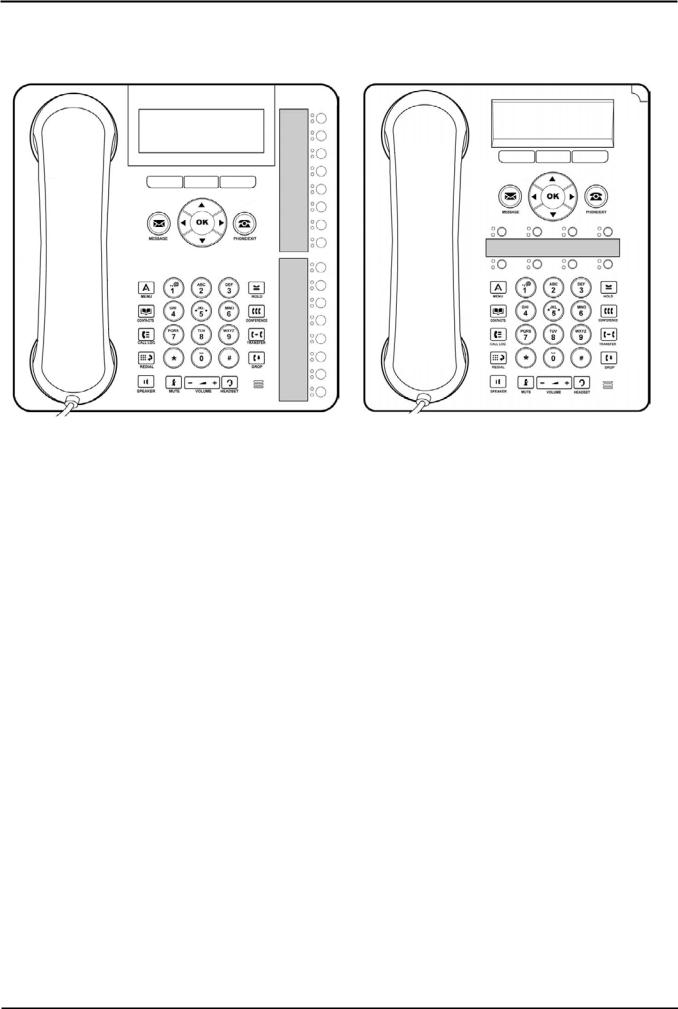
Introduction:
1. Introduction
This guide is for 1408, 1608, 1416 and 1616 phones when being used on an IP Office telephone system running IP Office
Release 6.0 software.
1416, 1616 Telephone |
1408, 1608 Telephone |
1.1Important Safety Information
∙! Warning: This handset may pickup small metal objects such as metal pins or staples.
∙During a power surge, EFT or ESD, calls may be dropped. After a power surge, EFT or ESD, it is normal for the
phone to restart.
∙Using a cell phone, mobile phone, GSM phone or two-way radio in close proximity to an Avaya telephone might cause interference.
∙The phone should not be connected directly to the outdoor telecommunication network.
1408, 1416, 1608 and 1616 Phone Guide |
Page 9 |
IP Office Release 6.0 |
15-601040 Issue 03g (19 November 2010) |
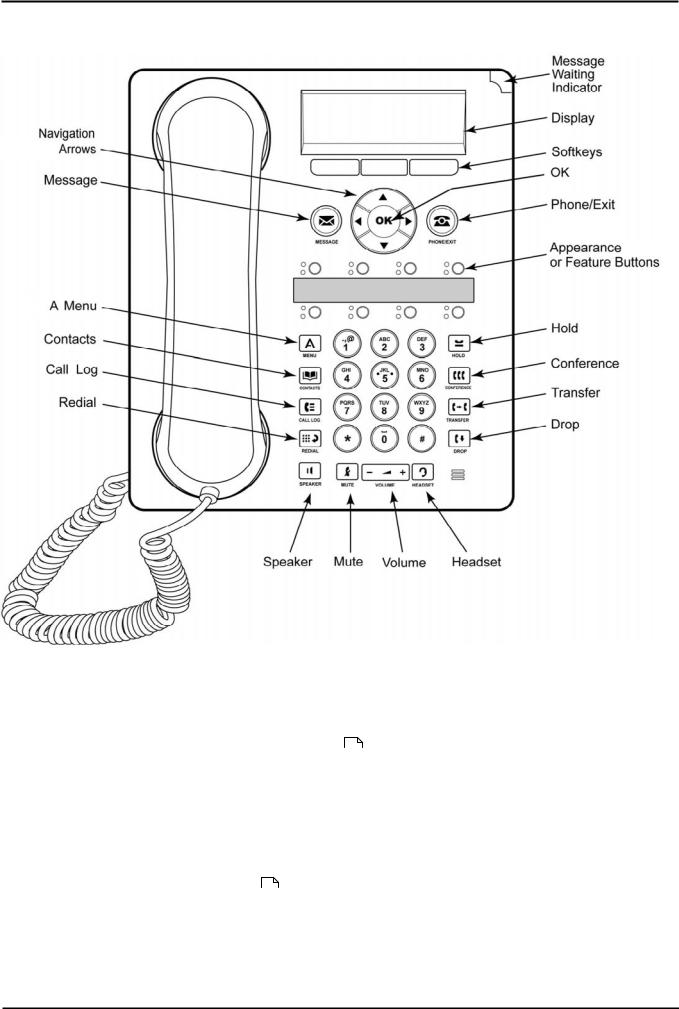
1.2 1408 and 1608 Phones
The diagram below shows the main features of a 1408 or 1608 phone.
∙This phone has 8 programmable buttons.
∙By default the first 3 buttons are used as appearance buttons for calls you make and receive. Your system administrator can configure additional appearance buttons.
∙Any button not configured as appearance buttons can be configured for a range of telephone system features. These are called feature buttons. Your system administrator can do this or, for a limited number of functions, you can do this using the phones self-administration 148 menu.
∙The phone includes an integral stand that can be flipped to either of two positions without needing any tools. When used in the upright position, a plastic peg in the earpiece rest area for the handset can be reversed if a more secure grip on the handset when not in use is required.
∙The phone includes a handsfree speaker and microphone for operation as a handsfree speakerphone. The speaker is located under the handset. The microphone is located at the bottom right of the keypad.
∙The phone includes a headset socket for connection of phone headsets.
∙The 1608 and 1616 phones are connect to the telephone system via the IP data network and so have some additional options, see IP Phone Features 15 .
1408, 1416, 1608 and 1616 Phone Guide |
Page 10 |
IP Office Release 6.0 |
15-601040 Issue 03g (19 November 2010) |
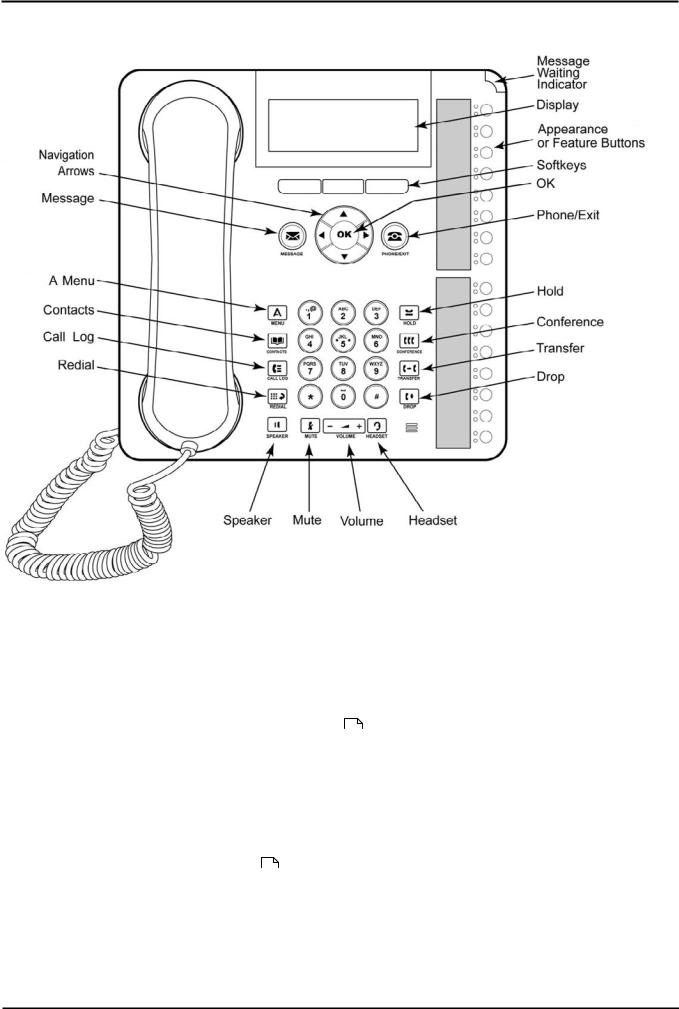
Introduction: 1408 and 1608 Phones
1.3 1416 and 1616 Phones
The diagram below shows the main features of a 1416 or 1616 phone.
∙The display angle can be adjusted for optimal viewing.
∙This phone has 16 programmable buttons.
∙The phone also supports up to 3 add-on BM32 button modules, each providing an addition 32 buttons.
∙By default the first 3 buttons are used as appearance buttons for calls you make and receive. Your system administrator can configure additional appearance buttons.
∙Any button not configured as appearance buttons can be configured for a range of telephone system features. These are called feature buttons. Your system administrator can do this or, for a limited number of functions, you can do this using the phones self-administration 148 menu.
∙The phone includes an integral stand that can be flipped to either of two positions without needing any tools. When used in the upright position, a plastic peg in the earpiece rest area for the handset can be reversed if a more secure grip on the handset when not in use is required.
∙The phone includes a handsfree speaker and microphone for operation as a handsfree speakerphone. The speaker is located under the handset. The microphone is located at the bottom right of the keypad.
∙The phone includes a headset socket for connection of phone headsets.
∙The 1608 and 1616 phones are connect to the telephone system via the IP data network and so have some additional options, see IP Phone Features 15 .
1408, 1416, 1608 and 1616 Phone Guide |
Page 11 |
IP Office Release 6.0 |
15-601040 Issue 03g (19 November 2010) |
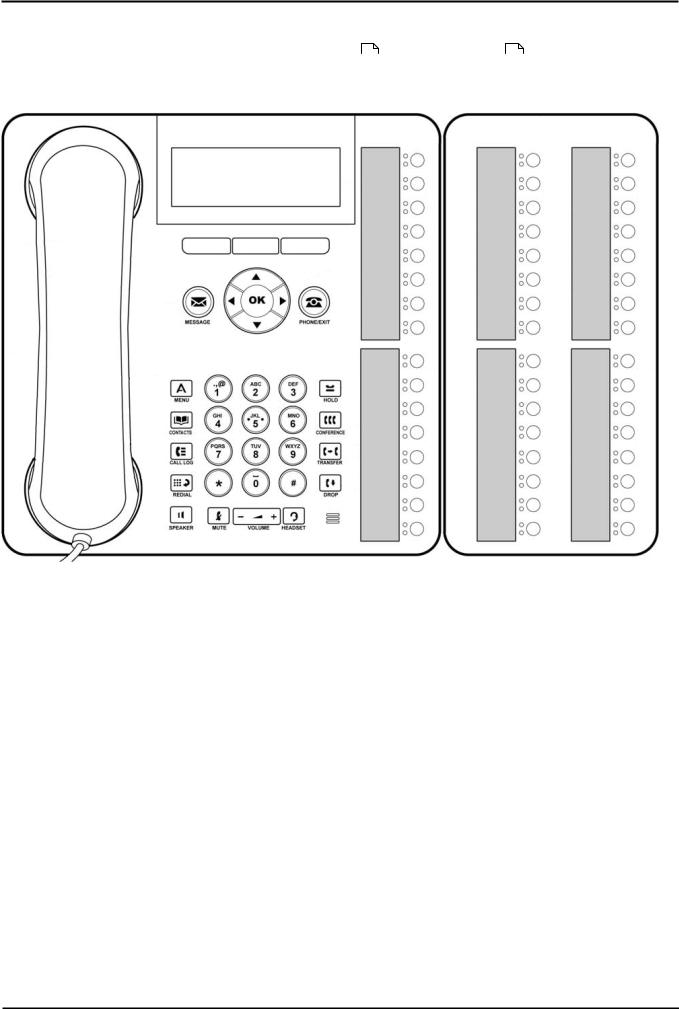
1.4 Button Modules
The 1416 and 1616 phones can support addition units called button modules. Each button module provides the phone with an additional 32 buttons which can be used as appearance buttons 19 and or feature buttons 148 .
Up to 3 button modules can be attached to a 1416 or 1616 phone. However the number of button modules supported by the telephone system may be limited by the total number of button modules attached to other phones on the telephone system.
∙Do not connect or disconnect a button module yourself. Your system administrator will arrange this if necessary. Failure to connect and restart the equipment in the correct order may cause the phone to not function correctly.
∙The button module used for 1416 phones is not interchangeable with that used for 1616 phones and vice versa.
1408, 1416, 1608 and 1616 Phone Guide |
Page 12 |
IP Office Release 6.0 |
15-601040 Issue 03g (19 November 2010) |
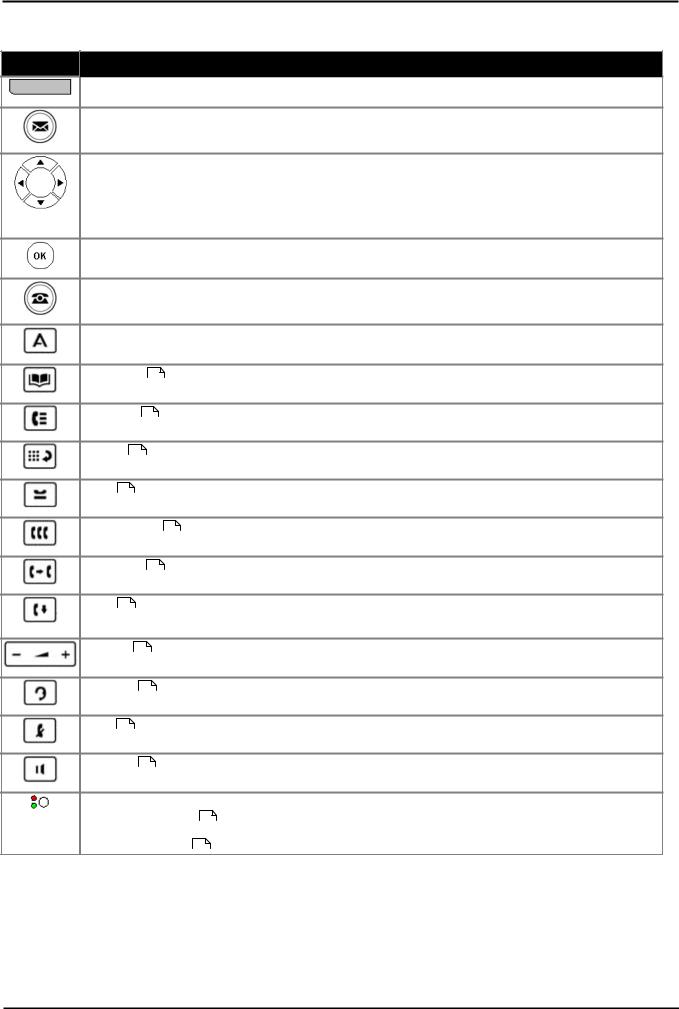
Introduction: Button Modules
1.5 Phone Keys
The following keys are found on the phone:
Key Description
Soft Keys - These 3 keys below the display have variable functions. When the key is active, its function is indicated by the text label above it. The left hand key is usually linked to the OK key.
Message - This key is used to access your voicemail system. By default this uses a series of menus on your phone's display.
Navigation Keys - Press the  up and down
up and down  arrow keys to scroll through lists. The
arrow keys to scroll through lists. The 

 arrow icons indicate where you are in a list. In some menus, you can also use the
arrow icons indicate where you are in a list. In some menus, you can also use the  left and right
left and right  arrow keys to enter and exit different levels of the menu. A menu option that accesses a sub-menu is indicated by the ...
arrow keys to enter and exit different levels of the menu. A menu option that accesses a sub-menu is indicated by the ...
dots (ellipsis) icon after its name.
In some menus, the  and
and  symbols in the display indicate a value that can be changed by pressing the
symbols in the display indicate a value that can be changed by pressing the  left and right
left and right  arrow keys.
arrow keys.
OK - The OK key normally matches the function offered by the left hand soft key below the screen.
PHONE/EXIT - This key is used to exit any menu you are in and return to the appearance buttons menu. During a call it can also be used to toggle the options displayed on the appearance menu.
MENU - This key is used to access a menu for phone settings and information.
CONTACTS 80 - This key is used to display the various directories (personal and shared) of names and telephone numbers to which you have access.
CALL LOG 90 - This key displays a record of you most recent answered, missed and outgoing calls. The button is illuminated when you have new missed calls.
REDIAL 46 - This key is used to either redial the last call you made or to show a list of the last calls you made from which you can select the number to redial.
HOLD 53 - This key is used to put the call you are currently talking to on hold.
CONFERENCE 68 - This key is used to start a conference call and to add callers to an existing
conference.
TRANSFER 60 - This key is used to transfer calls to another number.
DROP 38 - Press the Drop key to drop the active call. It can also be used to redirect a ringing call to voicemail. While on a conference call, you can press the Drop key to drop a person from the conference call.
VOLUME 182 - Press + plus or – minus on the Volume key to adjust the volume of the incoming call. Separate volumes can be adjusted for the ringer, handset, headset and speaker.
HEADSET 72 - This key is used to answer and end calls using a headset connected to the phones headset socket. The button is lit when you are connected to a call using the headset.
MUTE 38 - This key can be used to mute your speech to the currently connected call. The button is lit while mute is active.
SPEAKER 76 - This key is used to answer and end calls using the phone's handsfree speaker and microphone. The button is lit when you are connected to a call handsfree.
These keys have two roles:
∙Appearance Keys 19 -
These button represent calls that you can make or receive.
∙Feature Buttons 148 - Those key not configured as appearance keys can be used for other functions.
1408, 1416, 1608 and 1616 Phone Guide |
Page 13 |
IP Office Release 6.0 |
15-601040 Issue 03g (19 November 2010) |
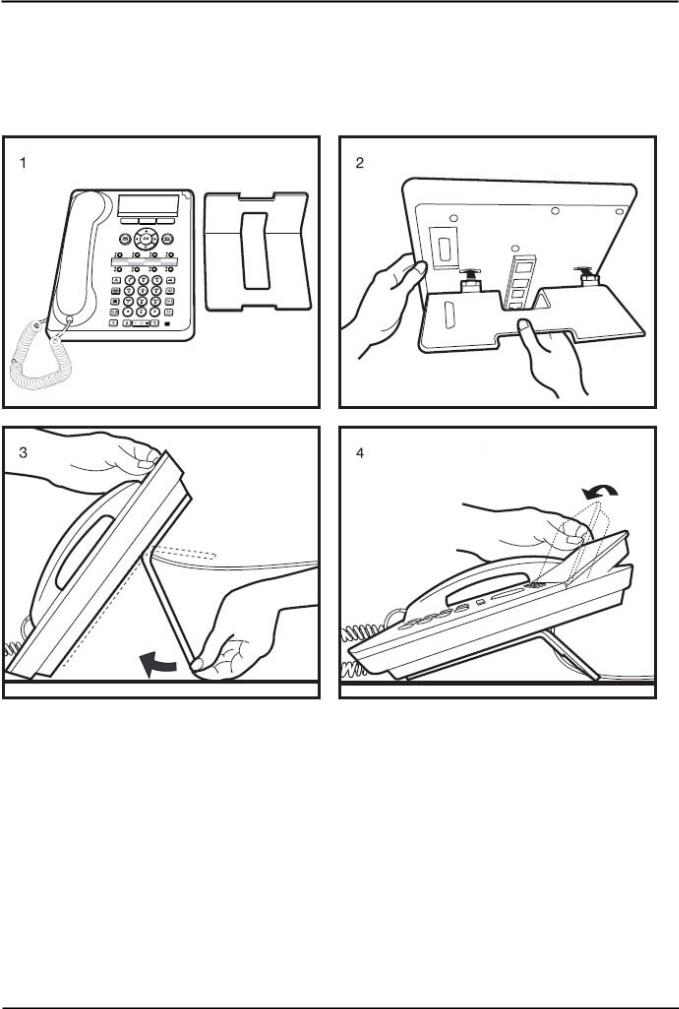
1.6 The Phone Stand
The phones all include a two-position stand that clips to the base of the phone as shown below. Once attached the stand can be used in either position to change the angle of the phone.
When changing the position of the stand, be sure to check that the stand has locked into the chosen position. A small plastic peg is located just under the phone's handset. This peg can be reversed to more securely anchor the handset when the stand places the phone in an upright position.
On the 1416 and 1616 phones, the angle of the phone display can also be adjusted as shown below.
1408, 1416, 1608 and 1616 Phone Guide |
Page 14 |
IP Office Release 6.0 |
15-601040 Issue 03g (19 November 2010) |

Introduction: The Phone Stand
1.7 Labels
Next to each call/line appearance button and feature button is a paper label. The label identifies the call/line appearance number or the feature that has been programmed on the button by your system administrator. You can remove the labels if you want to change a label or write on a blank one. Printed labels are also available for your telephone. See your system administrator for more information.
1.8 IP Phone Features (1608 and 1616)
The 1608 and 1616 phones connect to the phone system using an IP connection and support a number of additional features:
∙The phone uses a 10/100 Ethernet connection to connect to the telephone system via the IP network.
∙The phone includes a PC pass through 10/100 Ethernet port that can be used to also connect a computer to the network through the same connection as the phone. Use of this port can be disabled by the system administrator if not supported.
∙The phone may be powered from the network if Power over Ethernet (PoE) is available. Otherwise the phone needs its own power supply unit.
1408, 1416, 1608 and 1616 Phone Guide |
Page 15 |
IP Office Release 6.0 |
15-601040 Issue 03g (19 November 2010) |
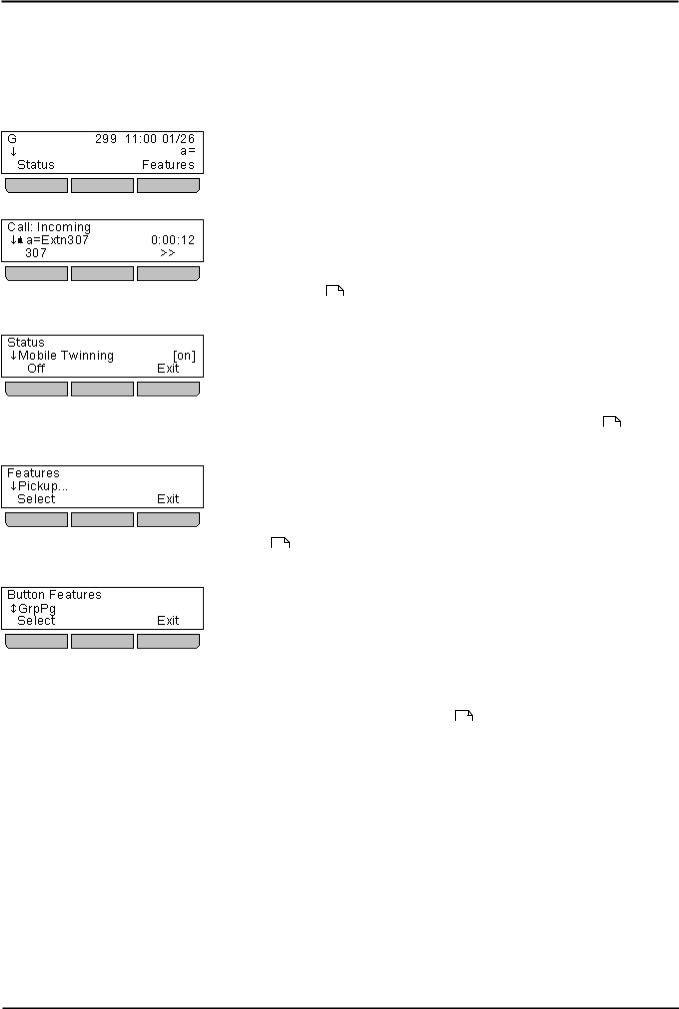
1.9 The Main Phone Menus
The main menus are detailed below. You can move between them using the  PHONE key. You can do this even during a call including when a call is alerting. In addition the menus are accessible from the call appearance menu by pressing the Status and Features soft keys when they are displayed.
PHONE key. You can do this even during a call including when a call is alerting. In addition the menus are accessible from the call appearance menu by pressing the Status and Features soft keys when they are displayed.
The Appearance Menu
Idle
Active
The Status Menu
This menu is used to display information about the  buttons that have been configured for appearance functions. These will normally be the first 3 button on the phone but the system administrator can configure additional buttons.
buttons that have been configured for appearance functions. These will normally be the first 3 button on the phone but the system administrator can configure additional buttons.
Using the  up and down
up and down  arrow keys you can scroll through the details of each of the buttons.
arrow keys you can scroll through the details of each of the buttons.
The display for buttons that currently have a call in progress will show details of the associated call.
The display for buttons that are idle will show the default label for the button and also soft key labels for accessing the other main menus.
Those buttons that have not been configured as appearance buttons can be used as feature buttons 148 .
The Status menu is not always visible. It is shown when you have any special call routing features active. For example do not disturb switched on.
It is also shown if the system administrator has given you the rights to change the status of your hunt group memberships or to change the service status of the hunt groups.
A summary of the menu options is shown in the Status Menu diagram 229 .
The Features Menu
The Features menu is used to access and configure range of your user settings. The system administrator can control some of the options that will be available to you within the menu. Typically these are settings stored by the telephone system which will be applicable even if you login at another phone.
A summary of the menu options is shown in the IP Office Features menu diagram 225 .
The Button Features Menu
Those  buttons not configured by the system administrators as appearance buttons can be used for other special features.
buttons not configured by the system administrators as appearance buttons can be used for other special features.
The button feature can be accessed by pressing the appropriate button. However they can also be accessed through the Button Features section of the Features menu (press the Features soft key and selecting Button Features). The  up and down
up and down  arrow keys can then be used to scroll through the programmed buttons. The associated button will briefly flash its red lamp.
arrow keys can then be used to scroll through the programmed buttons. The associated button will briefly flash its red lamp.
The action of each button is normally set by the system administrator. However you can also use the self-administer menu 148 to select and assign actions to the buttons.
1408, 1416, 1608 and 1616 Phone Guide |
Page 16 |
IP Office Release 6.0 |
15-601040 Issue 03g (19 November 2010) |
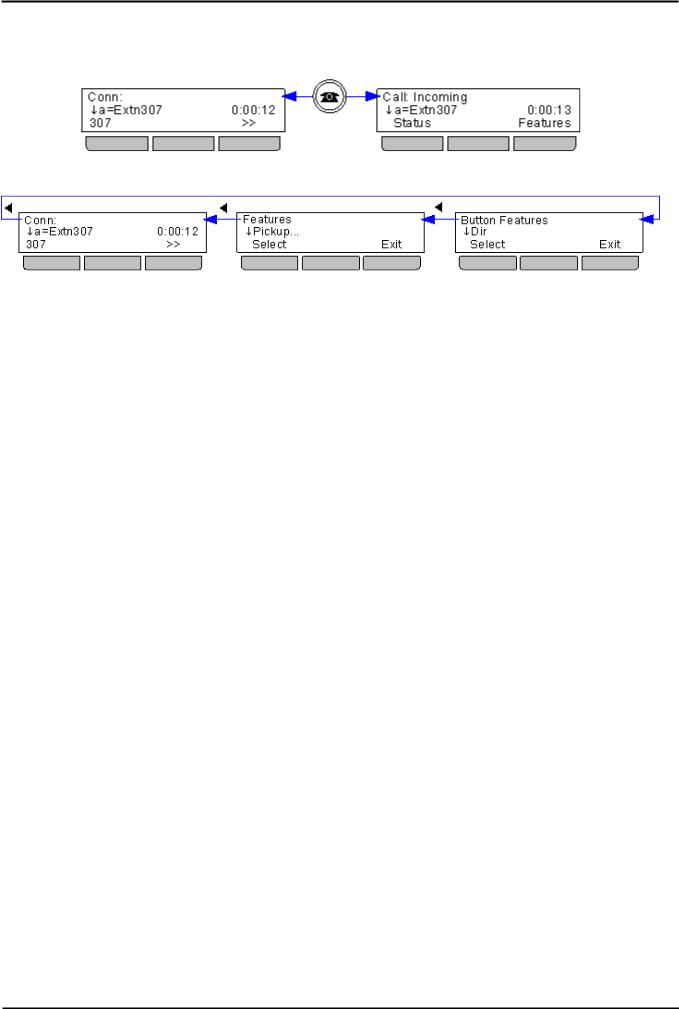
Introduction: The Main Phone Menus
Switching Menus
With a call connected, you can still access the other main menus. Press the  PHONE key to toggle between the normal appearance menu or one that lists the other menus accessible.
PHONE key to toggle between the normal appearance menu or one that lists the other menus accessible.
You can also use the  left arrow key to switch between the Appearance menu , Features menu and Button Features menu.
left arrow key to switch between the Appearance menu , Features menu and Button Features menu.
1408, 1416, 1608 and 1616 Phone Guide |
Page 17 |
IP Office Release 6.0 |
15-601040 Issue 03g (19 November 2010) |
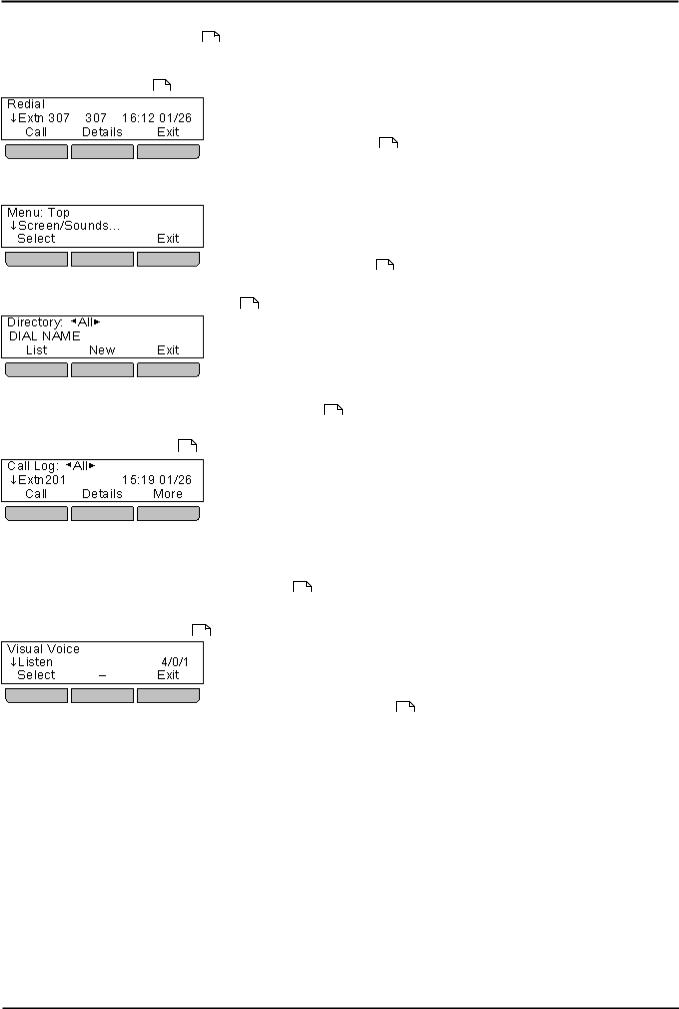
1.10 Other Menus
In addition to the main phone menus 16 , there are a number of additional menus which are accessed by pressing specific
keys.
 - The Redial Menu 46
- The Redial Menu 46
This menu accesses by pressing the  key. It shows a list of up to the 10 last outgoing calls that you have made.
key. It shows a list of up to the 10 last outgoing calls that you have made.
You can configure your phone 47 to simply redial the last number dialed in which case the menu is not shown.
 - The A Menu
- The A Menu
Pressing the  MENU key accesses a menu that can be used to control various phone settings. These are mainly settings stored by the phone rather than user settings that move with you.
MENU key accesses a menu that can be used to control various phone settings. These are mainly settings stored by the phone rather than user settings that move with you.
The Phone A-Menu diagram 230 shows a summary of the menu options.
 - The Contacts/Directory Menu 80
- The Contacts/Directory Menu 80
This menu is accessed by pressing the  key. It is used to display names and numbers that you can then use for making calls.
key. It is used to display names and numbers that you can then use for making calls.
The directory includes names stored for use by all users, names stored for use by just you and the name and numbers of all the other users and groups on the phone system.
The Contact Menu 233 diagram shows a summary of the menu options.
 - The Call Log Menu 90
- The Call Log Menu 90
This menu is accessed by pressing the  key. The call log you see is a call log stored on the telephone system. If you login at another 1408, 1416, 1608 or 1616 phone, your call log moves with you.
key. The call log you see is a call log stored on the telephone system. If you login at another 1408, 1416, 1608 or 1616 phone, your call log moves with you.
Your call log contains your 10 most recent answered calls, 10 most recent calls you made and 10 most recent missed calls.
If configured by the system administrator, it can also include calls missed by hunt groups of which you are a member.
The Call Log 232 menu diagram shows a summary of the menu options.
 - The Visual Voice Menu 96
- The Visual Voice Menu 96
This menu is accessed by pressing the  key. It is used to access the voicemail system and to then play messages in your voicemail mailbox, record and send messages to other users and to change various mailbox settings.
key. It is used to access the voicemail system and to then play messages in your voicemail mailbox, record and send messages to other users and to change various mailbox settings.
The Visual Voice menu diagram 228 shows a summary of the menu options.
1408, 1416, 1608 and 1616 Phone Guide |
Page 18 |
IP Office Release 6.0 |
15-601040 Issue 03g (19 November 2010) |
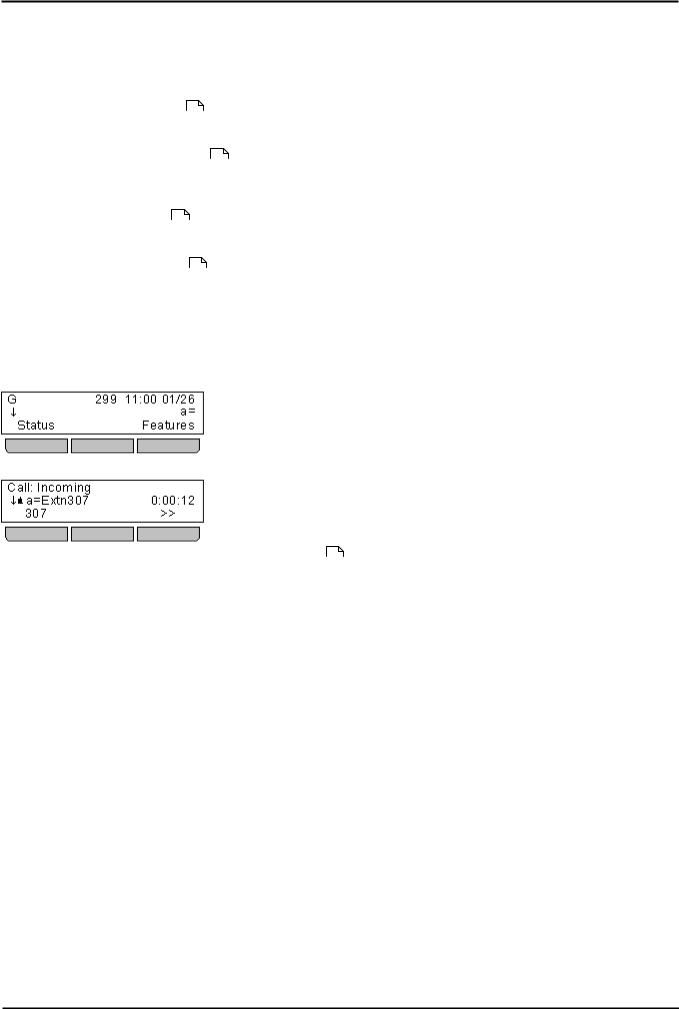
Introduction: Other Menus
1.11 Appearance Buttons/Menu
Appearance buttons are used to represent calls made and received by you and other users on the telephone system. They are configured by your system administrator. Normally your first 3 buttons are call appearance buttons but additional buttons can be configured as appearance buttons.
There are 4 different types of appearance keys that your system administrator can configure:
∙Call Appearance Buttons 21
These represent ordinary phone calls. Each call appearance that you have can be used to make and or receive calls. By default you normally have 3 call appearance keys and no other appearance keys.
∙Bridged Appearance Buttons 23
These appearance keys each match a specific call appearance key of another user. They allow you to answer the other user's calls on the matching call appearance or to make a call that the other user can then pickup using their matched call appearance.
∙Call Coverage Buttons 25
These appearance keys represent another user. When that other user has any calls alerting unanswered, the call coverage key for that user will start alerting and can be used to answer the call.
∙Line Appearance Buttons 27
These represent specific phone lines connected to the telephone system. You can use the button to make calls using that line or to answer calls on that line. Several users can have line appearance keys that represent the same line. Your phone's display and the key lamps will indicate when the line is being used by other users as well as by yourself.
Appearance Button Display/Menu
Idle
Active
This menu is used to display information about the  buttons that have been configured for appearance functions. These will normally be the first 3 button on the phone but the system administrator can configure additional buttons.
buttons that have been configured for appearance functions. These will normally be the first 3 button on the phone but the system administrator can configure additional buttons.
Using the  up and down
up and down  arrow keys you can scroll through the details of each of the buttons.
arrow keys you can scroll through the details of each of the buttons.
The display for buttons that currently have a call in progress will show details of the associated call.
The display for buttons that are idle will show the default label for the button and also soft key labels for accessing the other main menus.
Those buttons that have not been configured as appearance buttons can be used as feature buttons 148 .
1408, 1416, 1608 and 1616 Phone Guide |
Page 19 |
IP Office Release 6.0 |
15-601040 Issue 03g (19 November 2010) |

1.11.1 Using the Appearance Menu
These icons are shown to indicate the status of the call on the currently displayed appearance button:
1. Use the  up and down
up and down  arrow keys to scroll through details of the current call on each appearance button.
arrow keys to scroll through details of the current call on each appearance button.
2.If there is currently a call on the appearance button, an icon will be displayed indicating the status of the call.
∙ Alerting
Alerting
The call is alerting your phone.
∙ Connected
Connected
The call is the currently connected call to which you are talking.
∙ On Hold
On Hold
The call is on hold.
∙ Held Elsewhere
Held Elsewhere
The call has been put on hold by someone else who answered the call using an appearance button on their phone.
∙ Conference
Conference
The call is a conference call.
3.A >> double-arrow at the bottom left indicates that there are soft key options 32 available that could be applied to the call. To access these, press the >> double-arrow soft key and select the required function.
1.11.2 Phone Status Letters
The series of letters that appear in the top left of the display are used to indicate the status of various features.
∙B = Barred
A B is shown on your phone's display when the system administrator has set you to outgoing call barred status. You will only be able to make internal calls while this is applied.
∙D = Diverting (Forwarding) Calls
A D is shown on your phone's display when you have forward unconditional enabled.
∙G = Group Member (In Group)
A G is shown on your phone's display when have been configured as a member of a hunt group and your membership is enabled. While this is the case, you may receive calls targeted to the hunt group.
∙N = No Calls (Do Not Disturb)
An N is shown on your phone's display when you have do not disturb enabled.
∙O = Out of Service
An O is shown on your phone's display when any of the groups of which you are enabled as a member is set to night service mode. In that mode calls to that group are diverted to its fallback if set or otherwise to voicemail if available.
∙T = Twinned
A T is shown on a phone's display if it is internally twinned with your phone. Calls to you will alert on both phones and can be answered by you at either phone.
∙R = Resilience
An R is shown on your phone's display your phone is working in resilience mode. This is used when there may have been a problem with the telephone system to which your phone was registered and another IP Office system is currently providing support for your phone. In this mode, some features may not be available and calls may be routed differently.
∙S = System Alarm
If you are configured as a system administrator 208 , an S in the phone's display indicates a system alarm 221 .
(IP500 V2 only)
1408, 1416, 1608 and 1616 Phone Guide |
Page 20 |
IP Office Release 6.0 |
15-601040 Issue 03g (19 November 2010) |

Introduction: Appearance Buttons/Menu
1.11.3 Call Apperance Buttons
Call appearance buttons are used to display calls to and from your phone. By having several call appearance buttons, you are able to answer and make several calls, switch between calls and perform other actions.
When all your call appearance buttons are in use, any further calls to your number follow your forward on busy setting if set or otherwise go to voicemail if available.
Call Appearance Button Lamps
The following lamp states are used by appearance buttons configured to be call appearance buttons.
Button Lamps |
State |
||
|
|
|
|
|
Red off. |
Idle |
|
|
Green off. |
The call appearance is not in use and is not currently selected. |
|
|
Red on. |
Idle + Selected |
|
|
Green off. |
The call appearance is not in use but is the current selected button that will be used if the user |
|
|
|
goes off hook. |
|
|
Red off. |
Alerting |
|
|
Green slow flash. |
The matching call appearance is alerting for an incoming call. This is accompanied by ringing. If |
|
|
|
the user is already on a call, only a single ring is given. |
|
|
Red on. |
Alerting + Selected |
|
|
Green slow flash. |
As above but Ringing Line Preference has made this the user's current selected button. |
|
|
Red on. |
In Use Here |
|
|
Green on. |
The user has a call connected on the call appearance or is dialing. |
|
|
Red off. |
In Use Elsewhere |
|
|
Green on. |
The call appearance button is in use on a bridged appearance. |
|
|
Red off. |
On Hold Here |
|
|
Green fast flash. |
The call has been put on hold by this user. |
|
|
Red off. |
On Hold Elsewhere |
|
|
Green flash. |
A call on a bridged appearance button matched to the call appearance has been put on hold. |
|
|
|
Calls on a call appearance that are put on hold by another user will continue to show connected |
|
|
|
lamp status, though the phone display will indicate a held call. |
|
|
Red off. |
Inaccessible |
|
|
Green broken |
The button pressed is not accessible. The call is still dialing, ringing or cannot be bridged into. |
|
|
flash. |
|
|
|
|
|
|
1408, 1416, 1608 and 1616 Phone Guide |
Page 21 |
IP Office Release 6.0 |
15-601040 Issue 03g (19 November 2010) |
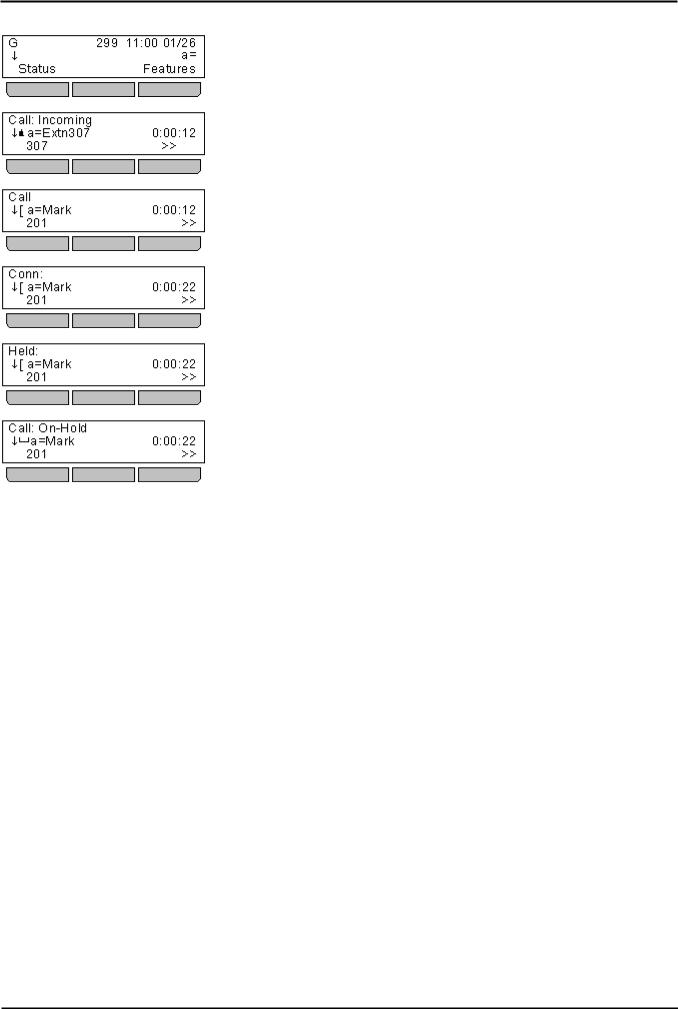
Call Appearance Button Display
Idle
Indicates that the call appearance is available to be used to make a call or to receive an incoming call.
Alerting
This call appearance is alerting with an incoming call. You can press the >> double-arrow soft key to select the Ignore or ToVm soft key options.
Outgoing Call
You have made a call with the appearance but it is not yet connected.
Connected
The appearance is the one with which you are currently talking.
Held
The call that you made or received on the call appearance has been put on hold by the other party.
Holding
You have put the call on hold.
1408, 1416, 1608 and 1616 Phone Guide |
Page 22 |
IP Office Release 6.0 |
15-601040 Issue 03g (19 November 2010) |
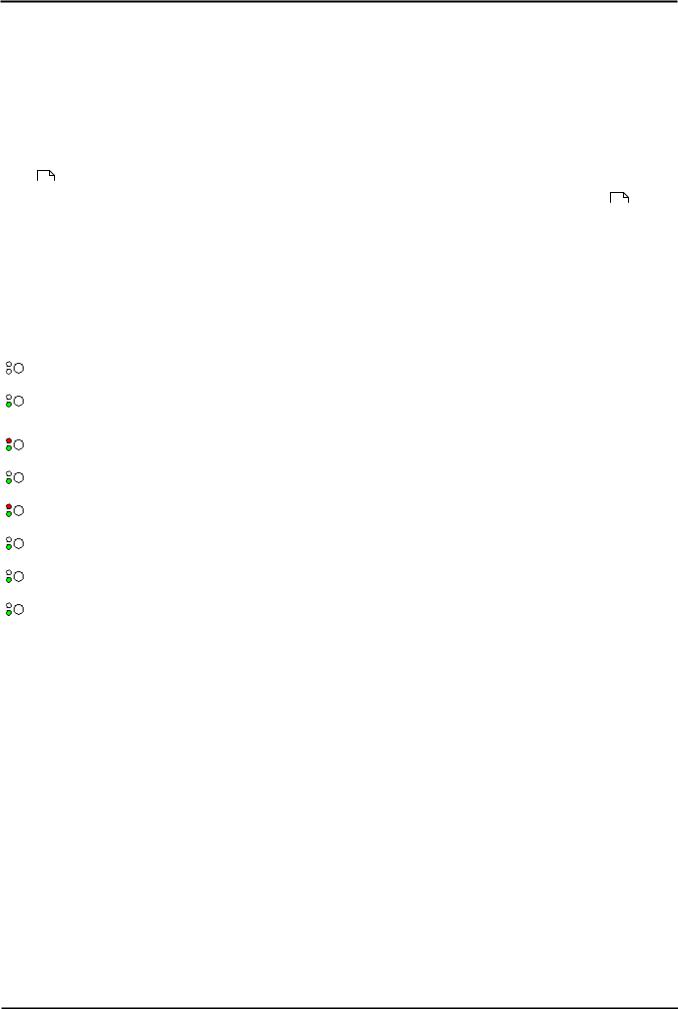
Introduction: Appearance Buttons/Menu
1.11.4 Bridged Appearance Buttons
A bridged appearance button shows the state of one of another user's call appearance buttons. It can be used to answer or join calls on that other user's call appearance button. It can also be used to make a call that the call appearance user can then join or retrieve from hold.
∙When the user's call appearance button alerts, your matching bridged appearance button also alerts. The bridged appearance button can be used to answer the call on the call appearance button user's behalf.
∙When the call appearance button user answers or makes a call using that call appearance, your matching bridged appearance button show the status of that call, for example connected, on hold, etc. The bridged appearance button can be used to retrieve the call if on hold or to join the call if active.
∙Bridged appearance buttons are not supported between users on different systems in a Small Community Network
243 .
If you have any bridged appearance and or call coverage buttons, you can set the type of ringing (coverage ring) 169 that should be used when a call alerts on any of those buttons. The options are to use normal ringing, a single non-repeated ring (abbreviated ring) or no ring. The coverage ring setting is only used if you do not already have a connected call. If you already have a connected call in progress, the shorter of your coverage ring and the system administrator set attention ring settings is used.
Bridged Appearance Button Lamps
The following lamp states are used by appearance buttons configured to be bridged appearance buttons.
Button Lamps |
Bridge Appearance Button State |
||
|
|
|
|
|
Red off. |
Idle |
|
|
Green off. |
The bridged appearance is not in use. |
|
|
Red off. |
Alerting |
|
|
Green slow flash. |
The matching call appearance is alerting for an incoming call. This is accompanied by ringing. |
|
|
|
If the user is already on a call, only a single ring is given. |
|
|
Red on. |
Alerting + Selected |
|
|
Green slow flash. |
As above but Ringing Line Preference has made this the user's current selected button. |
|
|
Red off. |
In Use Elsewhere |
|
|
Green on. |
The matching call appearance button is in use. |
|
|
Red on. |
In Use Here |
|
|
Green on. |
The user has made a call or answered a call on the bridged appearance, or bridged into it. |
|
|
Red off. |
On Hold Here |
|
|
Green fast flash. |
The call has been put on hold by this user. |
|
|
Red off. |
On Hold Elsewhere |
|
|
Green flash. |
The call on that call appearance has been put on hold by another user. |
|
|
Red off. |
Inaccessible |
|
|
Green broken |
The button pressed is not useable. The call is still dialing, ringing or cannot be bridged into. |
|
|
flash. |
|
|
|
|
|
|
1408, 1416, 1608 and 1616 Phone Guide |
Page 23 |
IP Office Release 6.0 |
15-601040 Issue 03g (19 November 2010) |
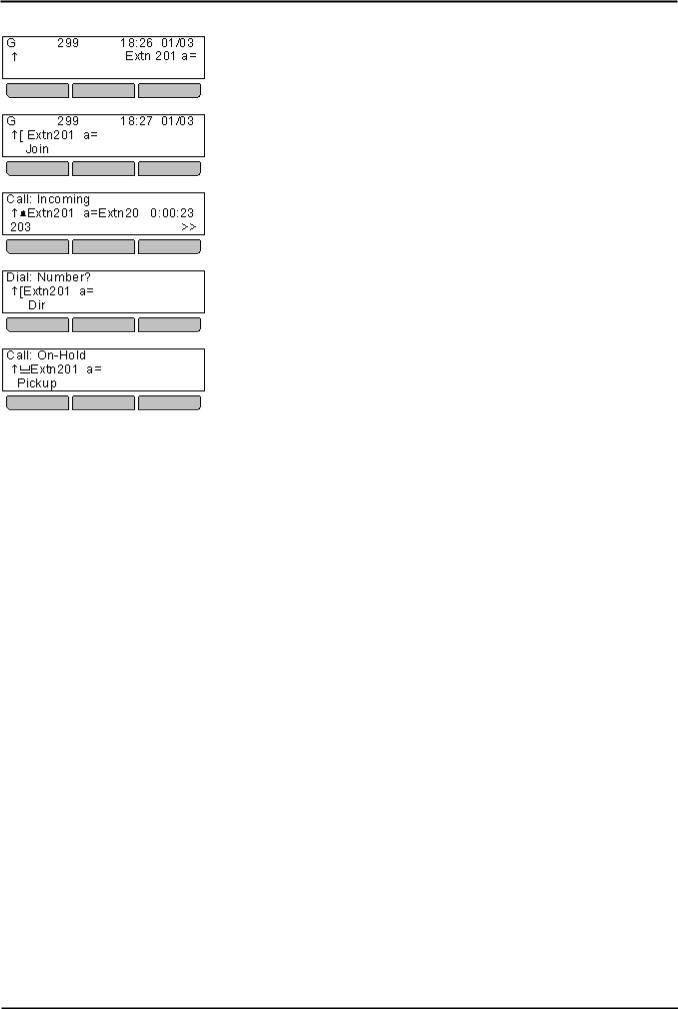
Bridged Appearance Button Display
Idle
By default, a bridged appearance is labeled with the name of the user and the label of their call appearance button that your bridged appearance matches.
In Use
The bridged appearance will show when the matching call appearance is in use on a call. The Join soft key, if displayed, indicates that you can intrude into the call to make it a conference call by pressing the soft key or the bridged appearance button.
Ringing
The bridged appearance will shown when the matching call appearance is being presented a call to answer. Typically just a single ring is given on your phone, however that can be changed by the system administrator. You can answer the call by pressing the bridged appearance button.
Making a Call
If idle (see above), you can press the bridged appearance to make a call. The matching call appearance will indicate that it is in use and the other user can join the call by pressing that call appearance.
Held Call
If the other user puts their call on the matching call appearance on hold, your bridged appearance will indicate the held call. You can retrieve the held call by pressing the Pickup soft key or pressing the bridged appearance button.
1408, 1416, 1608 and 1616 Phone Guide |
Page 24 |
IP Office Release 6.0 |
15-601040 Issue 03g (19 November 2010) |
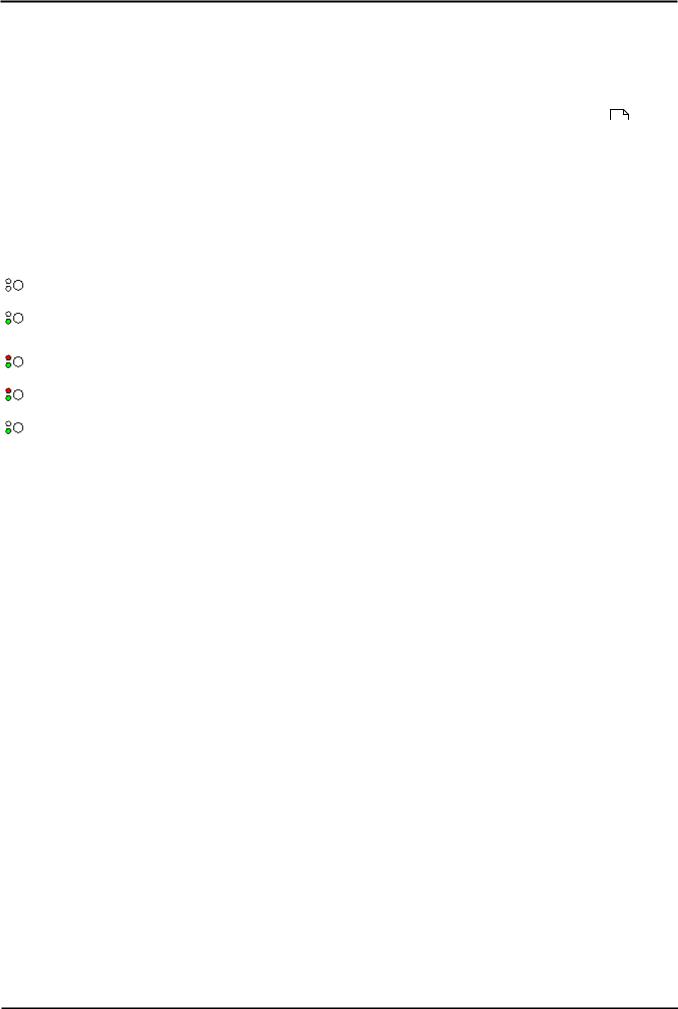
Introduction: Appearance Buttons/Menu
1.11.5 Call Coverage Buttons
Each call coverage button is associated with another user on your telephone system. The button allows you to be alerted when that user has an unanswered call still ringing. You can view the details of the call and answer it if required.
The settings of the user being covered control how long it rings at their phone before it also starts alerting on your call coverage button for that user. Call coverage appearance buttons are not supported between users on different systems in a Small Community Network.
If you have any bridged appearance and or call coverage buttons, you can set the type of ringing (coverage ring) 169 that should be used when a call alerts on any of those buttons. The options are to use normal ringing, a single non-repeated ring (abbreviated ring) or no ring. The coverage ring setting is only used if you do not already have a connected call. If you already have a connected call in progress, the shorter of your coverage ring and the system administrator set attention ring settings is used.
Call Coverage Button Lamps
The following lamp states are used by appearance buttons configured to be call coverage buttons.
Button Lamps |
Call Coverage Button State |
||
|
|
|
|
|
Red off. |
Idle |
|
|
Green off. |
The button is not in use. |
|
|
Red off. |
Alerting |
|
|
Green slow flash. |
The call coverage is alerting for an unanswered call at the covered user's phone. This is |
|
|
|
accompanied by ringing. If the user is already on a call, only a single ring is given. |
|
|
Red on. |
Alerting + Selected |
|
|
Green slow flash. |
As above but Ringing Line Preference has made this the user's current selected button. |
|
|
Red on. |
In Use Here |
|
|
Green on. |
The user has answered the call requiring coverage. |
|
|
Red off. |
On Hold Here |
|
|
Green fast flash. |
The covered call has been put on hold by the call coverage button user. |
|
|
|
|
|
1408, 1416, 1608 and 1616 Phone Guide |
Page 25 |
IP Office Release 6.0 |
15-601040 Issue 03g (19 November 2010) |
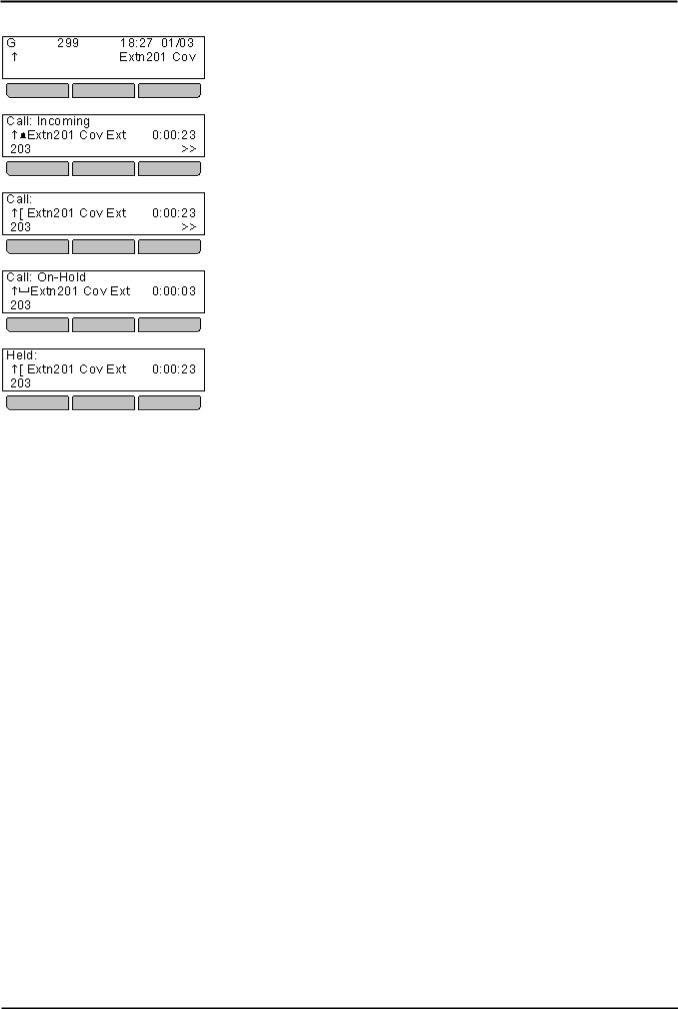
Call Coverage Button Display
Idle
By default the display shows the name of the user being covered and Cov. In this state the button cannot be used to make calls or perform other actions.
Alerting
If the covered user has any alerting call, when their call coverage time is reached the call will also being alerting on your call coverage button for that user. You can answer the call by pressing the button.
Connected
When you use the call coverage button to answer the call, it becomes your call.
On Hold
When you put the call on hold, the
Held
If the call is from another internal user and they put the call on hold, the held state is indicated. You can retrieve the call from hold by pressing the call coverage button again.
1408, 1416, 1608 and 1616 Phone Guide |
Page 26 |
IP Office Release 6.0 |
15-601040 Issue 03g (19 November 2010) |
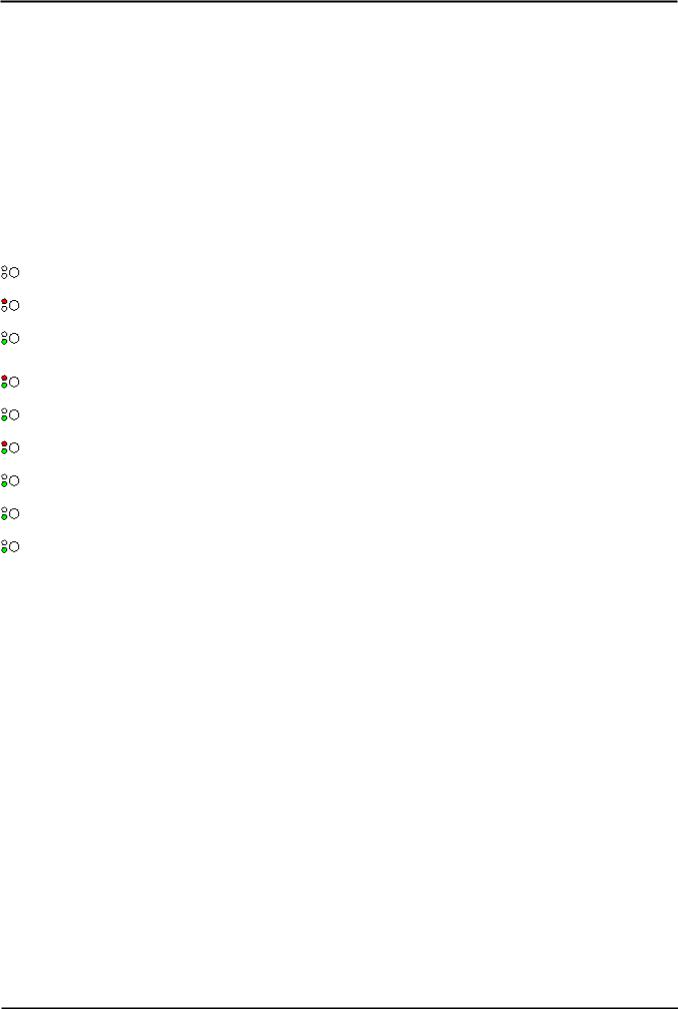
Introduction: Appearance Buttons/Menu
1.11.6 Line Appearance Buttons
Line appearance buttons allow you to make and receive calls on a specific telephone line connected to your telephone system. The button also allows you to see when the line is in use by other users.
For incoming calls, the telephone system still determines the destination for the call. That may be a user or group. However, if you have a line appearance button for the line, you will see that there is a call alerting and can answer it if required.
∙Private Lines
Special behaviour is applied to calls where the user has both a line appearance for the line involved and is also the Incoming Call Route destination of that call. Such calls will alert only on the Line Appearance button and not on any other buttons. These calls will also not follow any forwarding.
Line Appearance Button Lamps
The following lamp states are used by appearance buttons configured to be line appearance buttons.
Button Lamps |
Line Appearance Button State |
||
|
|
|
|
|
Red off. |
Idle |
|
|
Green off. |
The associated line is not in use. |
|
|
Red on. |
Idle + Selected |
|
|
Green off. |
The associated line is not in use but the button is the user currently selected button. |
|
|
Red off. |
Alerting |
|
|
Green slow flash. |
The line is ringing at it incoming call route destination. This is accompanied by ringing. If the |
|
|
|
user is already on a call, only a single ring is given. |
|
|
Red on. |
Alerting + Selected |
|
|
Green slow flash. |
As above but Ringing Line Preference has made this the user's current selected button. |
|
|
Red off. |
In Use Elsewhere |
|
|
Green on. |
The line is in use. |
|
|
Red on. |
In Use Here |
|
|
Green on. |
The user has answered the line, made a call on it or bridged into the call on the line. |
|
|
Red off. |
On Hold Here |
|
|
Green fast flash. |
The call on the line has been put on hold by this user. |
|
|
Red off. |
On Hold Elsewhere |
|
|
Green flash. |
The call on the line has been put on hold by another appearance button user. |
|
|
Red off. |
Inaccessible |
|
|
Green broken |
The button pressed is not accessible. The call is still dialing, ringing, routing or cannot be |
|
|
flash. |
bridged into. |
|
|
|
|
|
1408, 1416, 1608 and 1616 Phone Guide |
Page 27 |
IP Office Release 6.0 |
15-601040 Issue 03g (19 November 2010) |

Chapter 2.
Making Calls
1408, 1416, 1608 and 1616 Phone Guide |
Page 29 |
IP Office Release 6.0 |
15-601040 Issue 03g (19 November 2010) |
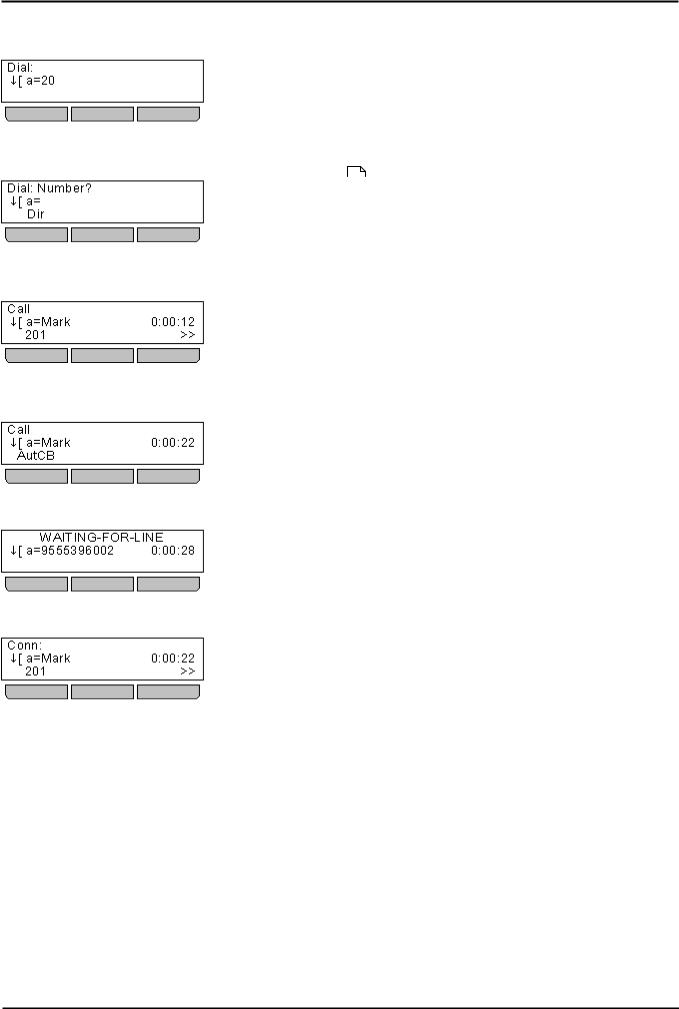
2. Making Calls
If you are not already on a call, then you can just dial the number. The currently selected appearance button, shown by a red lamp, will be used for the call.
Alternatively, you can press a specific appearance button in order to make a call using that button. Using this method you can press the Dir soft key to select a number from the directory 83 .
If the number you dial matches a user or group on the telephone system, the directory name of the user or group is shown and the call starts altering the target.
If the call is to a user, and they do not answer, press the >> double-arrow soft key to access additional options. For example, to set a callback, press the AutCB soft key.
If the call is external and no external line is currently available, the message WAITING FOR LINE is displayed.
The display will indicate when the call is connected to the destination or to an outgoing line.
1408, 1416, 1608 and 1616 Phone Guide |
Page 30 |
IP Office Release 6.0 |
15-601040 Issue 03g (19 November 2010) |
